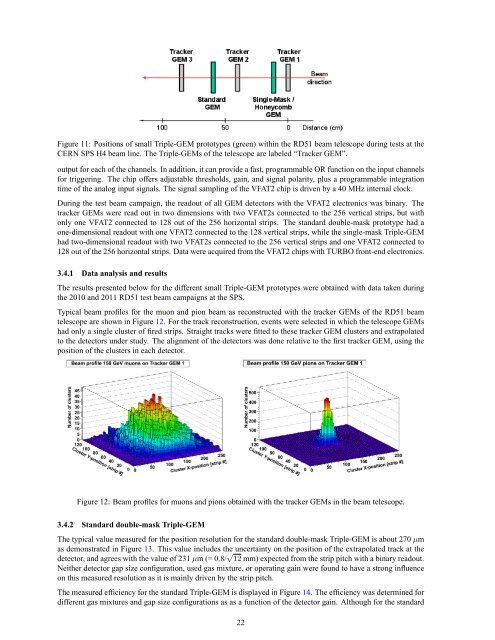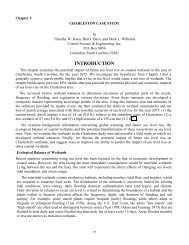A GEM Detector System for an Upgrade of the CMS Muon Endcaps
A GEM Detector System for an Upgrade of the CMS Muon Endcaps
A GEM Detector System for an Upgrade of the CMS Muon Endcaps
Create successful ePaper yourself
Turn your PDF publications into a flip-book with our unique Google optimized e-Paper software.
Figure 11: Positions <strong>of</strong> small Triple-<strong>GEM</strong> prototypes (green) within <strong>the</strong> RD51 beam telescope during tests at <strong>the</strong><br />
CERN SPS H4 beam line. The Triple-<strong>GEM</strong>s <strong>of</strong> <strong>the</strong> telescope are labeled “Tracker <strong>GEM</strong>”.<br />
output <strong>for</strong> each <strong>of</strong> <strong>the</strong> ch<strong>an</strong>nels. In addition, it c<strong>an</strong> provide a fast, programmable OR function on <strong>the</strong> input ch<strong>an</strong>nels<br />
<strong>for</strong> triggering. The chip <strong>of</strong>fers adjustable thresholds, gain, <strong>an</strong>d signal polarity, plus a programmable integration<br />
time <strong>of</strong> <strong>the</strong> <strong>an</strong>alog input signals. The signal sampling <strong>of</strong> <strong>the</strong> VFAT2 chip is driven by a 40 MHz internal clock.<br />
During <strong>the</strong> test beam campaign, <strong>the</strong> readout <strong>of</strong> all <strong>GEM</strong> detectors with <strong>the</strong> VFAT2 electronics was binary. The<br />
tracker <strong>GEM</strong>s were read out in two dimensions with two VFAT2s connected to <strong>the</strong> 256 vertical strips, but with<br />
only one VFAT2 connected to 128 out <strong>of</strong> <strong>the</strong> 256 horizontal strips. The st<strong>an</strong>dard double-mask prototype had a<br />
one-dimensional readout with one VFAT2 connected to <strong>the</strong> 128 vertical strips, while <strong>the</strong> single-mask Triple-<strong>GEM</strong><br />
had two-dimensional readout with two VFAT2s connected to <strong>the</strong> 256 vertical strips <strong>an</strong>d one VFAT2 connected to<br />
128 out <strong>of</strong> <strong>the</strong> 256 horizontal strips. Data were acquired from <strong>the</strong> VFAT2 chips with TURBO front-end electronics.<br />
3.4.1 Data <strong>an</strong>alysis <strong>an</strong>d results<br />
The results presented below <strong>for</strong> <strong>the</strong> different small Triple-<strong>GEM</strong> prototypes were obtained with data taken during<br />
<strong>the</strong> 2010 <strong>an</strong>d 2011 RD51 test beam campaigns at <strong>the</strong> SPS.<br />
Typical beam pr<strong>of</strong>iles <strong>for</strong> <strong>the</strong> muon <strong>an</strong>d pion beam as reconstructed with <strong>the</strong> tracker <strong>GEM</strong>s <strong>of</strong> <strong>the</strong> RD51 beam<br />
telescope are shown in Figure 12. For <strong>the</strong> track reconstruction, events were selected in which <strong>the</strong> telescope <strong>GEM</strong>s<br />
had only a single cluster <strong>of</strong> fired strips. Straight tracks were fitted to <strong>the</strong>se tracker <strong>GEM</strong> clusters <strong>an</strong>d extrapolated<br />
to <strong>the</strong> detectors under study. The alignment <strong>of</strong> <strong>the</strong> detectors was done relative to <strong>the</strong> first tracker <strong>GEM</strong>, using <strong>the</strong><br />
position <strong>of</strong> <strong>the</strong> clusters in each detector.<br />
Figure 12: Beam pr<strong>of</strong>iles <strong>for</strong> muons <strong>an</strong>d pions obtained with <strong>the</strong> tracker <strong>GEM</strong>s in <strong>the</strong> beam telescope.<br />
3.4.2 St<strong>an</strong>dard double-mask Triple-<strong>GEM</strong><br />
The typical value measured <strong>for</strong> <strong>the</strong> position resolution <strong>for</strong> <strong>the</strong> st<strong>an</strong>dard double-mask Triple-<strong>GEM</strong> is about 270 µm<br />
as demonstrated in Figure 13. This value includes <strong>the</strong> uncertainty on <strong>the</strong> position <strong>of</strong> <strong>the</strong> extrapolated track at <strong>the</strong><br />
detector, <strong>an</strong>d agrees with <strong>the</strong> value <strong>of</strong> 231µm (= 0.8/ √ 12 mm) expected from <strong>the</strong> strip pitch with a binary readout.<br />
Nei<strong>the</strong>r detector gap size configuration, used gas mixture, or operating gain were found to have a strong influence<br />
on this measured resolution as it is mainly driven by <strong>the</strong> strip pitch.<br />
The measured efficiency <strong>for</strong> <strong>the</strong> st<strong>an</strong>dard Triple-<strong>GEM</strong> is displayed in Figure 14. The efficiency was determined <strong>for</strong><br />
different gas mixtures <strong>an</strong>d gap size configurations as as a function <strong>of</strong> <strong>the</strong> detector gain. Although <strong>for</strong> <strong>the</strong> st<strong>an</strong>dard<br />
22
















